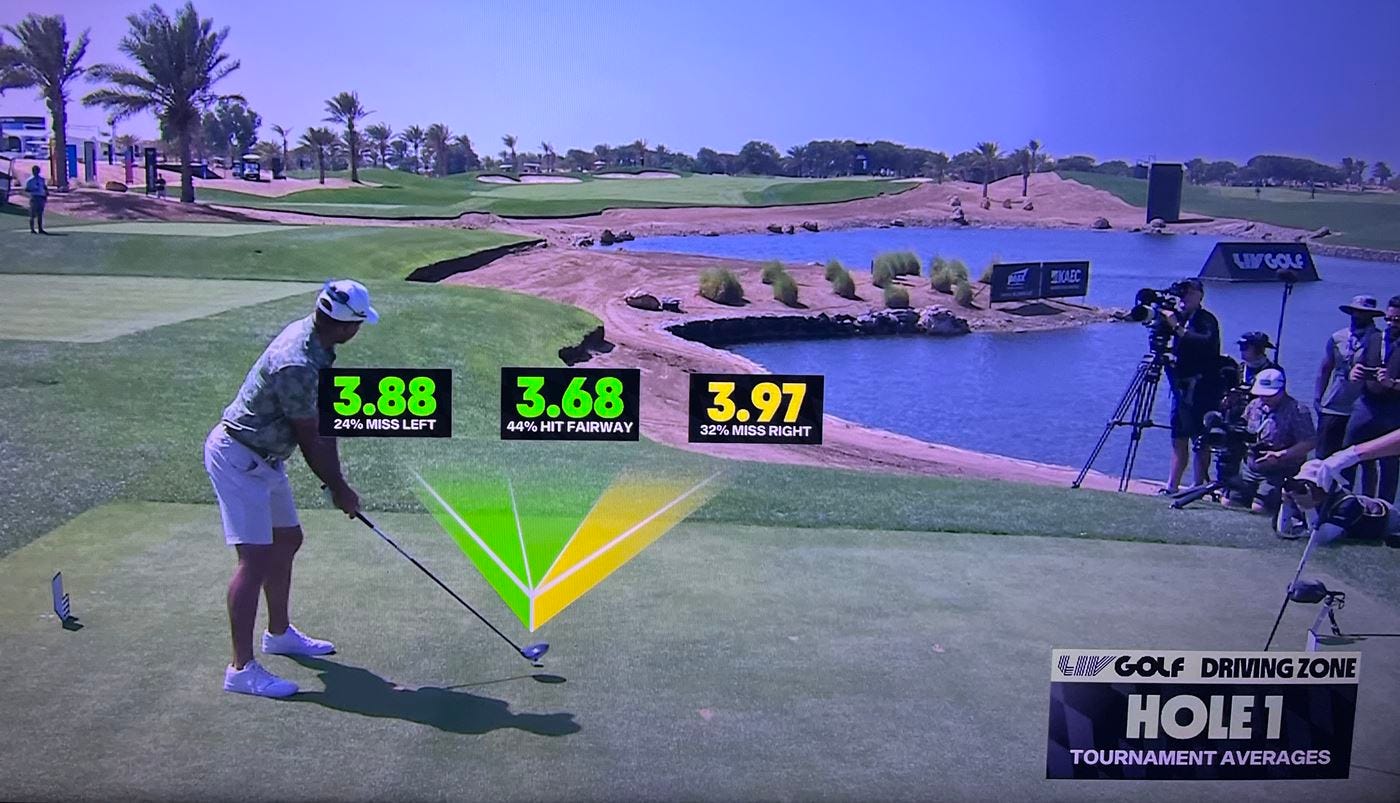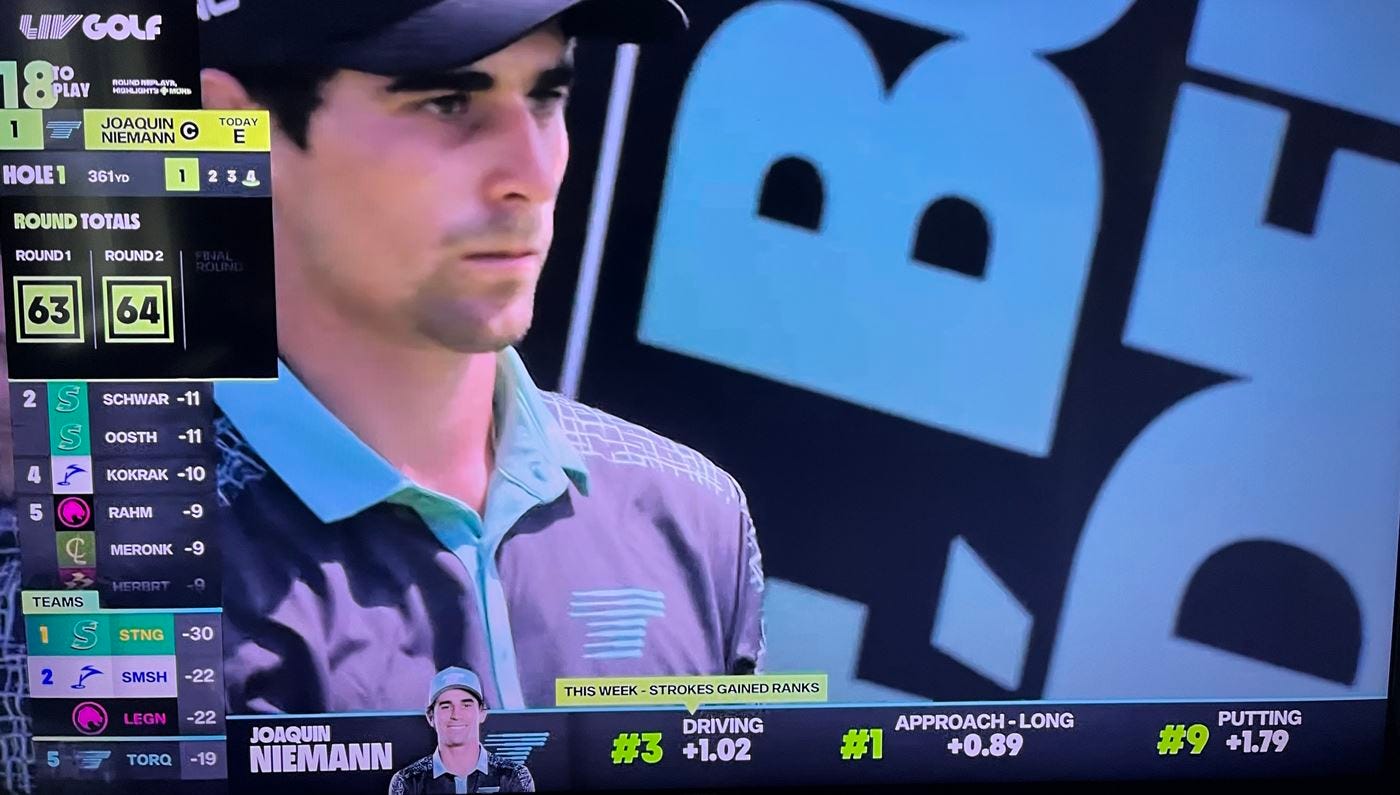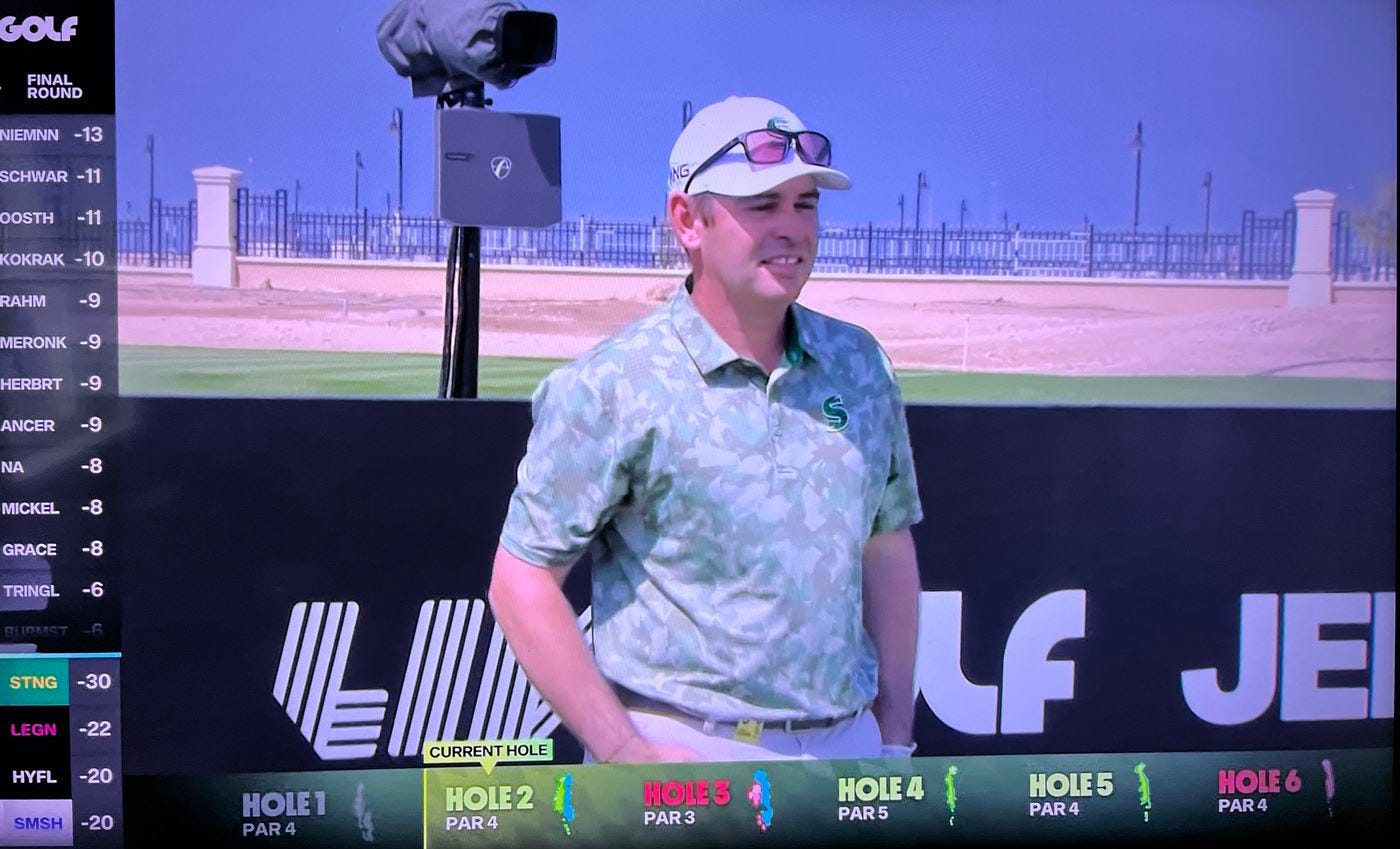Golf as entertainment: TV innovations, Topgolf, simulators and the golf industry
In this week's edition, we look at golf as entertainment amid new data on Topgolf and simulator participation and calls for innovation in the TV product.
This article is 2598 words. It should take you approximately 12 minutes to read
In this week’s newsletter:
Off-course play and the changing face of golf
Can golf execs make watching golf on TV more entertaining?
Thank you for being here. The Wedge is a reader-supported publication. If you enjoy these articles and would like to support independent media focused on the business, money and mystique of the world’s greatest game, please consider a monthly or annual subscription or gift a subscription to someone who might value this content.
On-course and off-course golf: Friends or foes?
The past two weeks have seen some fascinating new data on participation numbers in the US, published by the National Golf Foundation industry body.
The data had a special focus on the number of on-course players, the number of off-course players — for example, those who play at Topgolf and simulator experiences — and the overlap between the two.
There are several surprising headline findings:
Over 6 million more people in the US play off-course golf only versus on-course golf only
The average age of off-course golf participants is 15 years younger than on-course players
Women are 50% more likely to play off-course than on-course golf (42% of off-course only participants vs 28% of on-course only)
People of color are approximately twice as likely to play off-course than on-course (43% vs 22%)
Another data point, which from my vantage point is perhaps the most surprisingly of all — the percentage of higher income earners (defined in the survey as having more than $100,000 in household income) is effectively the same between the two cohorts: 42% of on-course only players have a household income of more than $100k, while 41% of off-course only players meet the same earnings threshold.
Topgolf and simulators are much more accessible to newbies than on-course, with its generally labyrinthine social rules and often unmistakable atmosphere of elitism and exclusion.
Breaking down the numbers in relation to women and minorities (the terminology used in the survey was “people of color”), we can extrapolate the following:
Almost 7.8 million women in America play off-course golf only (42% of 18.5 million people)
Against less than 3.4 million women in America who play on-course only (23% of 12.1 million)
More than 7.9 million people of color in America play off-course golf only (43% of 18.5 million)
Against less than 3.4 million people of color in American who play on-course only (23% of 12.1 million)
The diversity headlines apart, the data offers further evidence of what we saw in reviewing the Topgolf performance within the Callaway corporation since acquisition.
From that report:
Figures for 2022, the first full year following the acquisition, showed that Topgolf was the largest segment of Callaway’s overall revenue for the year (39% for Topgolf, against 35% for “golf equipment”, including clubs, balls and the market-leading Odyssey putter range, and 26% for “active lifestyle”, or clothing).
Topgolf added 11 new venues in 2022 to a total of more than 80, and more are being added all the time.
Back to the NGF data on off-course versus on-course participation, and broadly, the numbers are impressive.
The year-on-year growth the data shows is more impressive still.
The number of off-course only participants in 2023 was up 19% year on year. Put another way, it looks like more than 3 million more people played off-course golf in America in 2023, many of those likely playing for the first time.
In addition to these two cohorts — the solely Topgolf / simulator brigade versus the green-grass-only set — there are an additional 14.5 million people in America who play both.
This gives a total participation number of 45 million “total golf participants” in America.
The terminology here is interesting.
“Golf participants” have generally just been called “golfers”, but whether many of the off-course-only players would openly describe themselves as “golfers” must be a subject of some speculation.
Still, where there is participation there is opportunity — and the broader golf industry believes it is well-placed to benefit from what it sees as a definite golf boom.
Some of the roots of that boom can be traced back to the Covid-19 pandemic, when general, widespread and often draconian lockdowns created a massive appetite for outdoor recreation around the world and golf, with its natural social distancing and limited scope for contagion, was one of the first sports given the green light to throw open its tee-boxes. (Another feature was the new work-from-home, which offered leeway for some staff and executives to escape to the fairways during office hours.)
There are other reasons for the golf boom, though, that likely have little or nothing to do with the pandemic.
One of those is the expansive and still, even after more than a decade, under-appreciated influence of digital and social media.
Given that you, me and everyone we know has an entirely different, personalized and often carefully cultivated set of information sources, the impact of social media — and especially shortform video on TikTok, Instagram Reels and YouTube Shorts — in energizing people to do something can hardly be overestimated.
In the race to act on the videos pumped out by their chosen influencers, golf newbies have found off-course golf such as Topgolf and simulators much more accessible than the course, the club and the locker-room, with their generally labyrinthine social rules and often unmistakable atmosphere of elitism and exclusion.
Hiding in the on-course / off-course playing data
Hiding in the NGF infographic was one interesting data point: the number of on-course only participants, 12.1 million, was down 8 per cent in 2023 vs 2022.
We can interpret this in at least two contrasting ways:
As the other two cohorts increased significantly — off-course only players up 19%, people who play both up 17% — the drop in on-course only players is simply an unavoidable effect of the massive rise in off-course, and the growing numbers of Topgolf/simulator players will be a conveyor belt to bring people into the more established and traditional version of the game.
Or, in contrast:
There is a danger that off-course golf — with its demonstrably greater appeal to younger and more diverse demographics — could cannibalize the on-course game over time, allowing the off-course version to boom while the on-course demographic continues to have an older, whiter and more male hue.
The industry — perhaps like the proverbial swan, paddling furiously under the surface while maintaining a serene expression above it — is naturally preferring to point to #1 here.
Dan Murphy, the CEO of Bridgestone Golf, spoke about this on the Bloomberg Business of Sports podcast last week.
He said (emphasis ours throughout):
“This whole activity of off-course is really helping, meaning Topgolf or simulator golf. That has become very, very popular for the last 5 or 10 years and I think that’s acted as a feeder system to really keep golf going in a big way and nourish our participation numbers in a very positive way.
“We [Bridgestone] are totally on-course … Bridgestone Golf makes golf balls, so we’re mostly interested in people getting out onto a green grass golf course and playing and hitting those balls in the woods so we can replace them, right!? [Cue laughter in the studio]
“At first, when the off course business really started to take off, some of us traditionalists were worried about it.
We said, ‘Oh my gosh, there’s only so many golf dollars from a consumer perspective, are these guys going to take golf time and money away from us?’
And the answer has clearly been, ‘No’
It’s become a feeder system, almost an entry point for golfers.
If you go to Topgolf you can have a beer and hit some golf balls in a very friendly environment with your family or friends and that makes you more likely to come out and experience green-grass golf, which is where we benefit.”
It will be interesting to see whether that — especially the last claim, that going to Topgolf makes you more likely to go to the club — really is the case.
Hitting the same optimistic note, the NGF release ended (our emphasis):
“Off-course engagement and social media have played key roles in golf’s popularity and cool factor, as celebrities, athletes, and content creators with sizeable followings are boosting golf’s positive visibility, especially among non-golfers … Golf is getting younger and cooler… what an amazing time to be involved in this game.”
The Wedge newsletter content is currently free, but I’d love it if you smashed that button. 🏌️ 🚀
Will PGA Tour, SSG and LIV spark an arms race in TV innovation and entertainment?
The second item of interest this week is actually more closely related to the first than might seem obvious at first.
On the face of it, off-course versus on-course participation data does not really have much to do with possible changes to the PGA Tour product following its recent deal with the SSG group of billionaire sports owners and investors.
But when we look closer, there is probably a large and growing overlap in this Venn diagram.
And it all boils down to entertainment.
In the age of limitless social media feeds and endless 1-minute video clips, what’s entertaining gets the most eyeballs, and what gets the most eyeballs wins
Golf lived and breathed on tradition, heritage and status for several decades.
But can tradition, heritage and status survive a face-off with the digital revolution?
Incumbents across many other industries have found out the answer to that question, and changed whatever they could do to survive.
For almost all people in the total addressable market, golf is an entertainment product now for participants and viewers alike.
This is obvious to Netflix executives, for whom Full Swing season 1 and 2 over the past 12 months has attracted more chatter and attention than the final round of either the US Open or the (British) Open Championship.
This is not to intend any disrespect to Wyndham Clark or Brian Harman, but few people without the last name of Clark or Harman will have experienced a racing pulse on those Sundays last summer.

Entertainment is what attracts. And the sad reality is that too much of top-level golf, including at the Majors, is just not that entertaining.
It might have great appeal to a purist who relishes seeing the tournament leader navigate a Sunday in driving English rain, or loves jumping onto Twitter X to complain about the latest ridiculous temporary obstruction relief for a tour pro’s wild tee-shot.
But is that entertainment?
We can like it or loathe it, but in the age of limitless social media feeds and endless 1-minute video clips, what’s entertaining gets the most eyeballs, and what gets the most eyeballs wins.
So if golf executives and television production pros are not frantically thinking up ways to energize their coverage, well, there’s something badly wrong somewhere.
Sticking an Airpod in a pro’s ear for a fairway walk is a start, but there has to be significant TV and video-on-demand advances in 2024 if golf is to avoid losing any more ground to all the other countless things that will attract people’s attention.
Rickie Fowler knows
Rickie Fowler knows this.
He doesn’t wear orange just because he likes the color. He wears orange because orange gets attention, and attention is oxygen. (Having film-star looks to back it up is of course a great help.)
Fowler allowed some honesty into the generally inane pre-tournament interviews last week.
Before the Cognizant Classic at Palm Beach Gardens in Florida, Fowler was asked by gathered media whether he had any “big ideas” to share with the PGA Tour and their SSG backers.
He said (emphasis ours throughout):
“I’m excited about the partnership because I feel like there’s some very smart and influential people part of that SSG group that I feel like ultimately can help the Tour evolve and head in a potentially better direction and be in a better position for the future.
“As far as big ideas, not necessarily. That’s a rabbit hole we could go down…”
“Please do”, came the invitation, as per the Golf.com report.
“No, I feel like ultimately we’re in the entertainment business, and we’ve got to figure out a better way to entertain our fans and it come across better on TV.
How we do that, I don’t exactly know, but like I said, I feel like with the people that are involved, I definitely trust the guys, the players that have been involved, and I feel like the guys — especially since they’re not just golf guys, I think they have enormous respect for the game of golf, but also they come from a lot of different avenues in sports and business, and I feel like they can help us kind of give direction on where we can or need to go.
…
“[Golf is] also a very traditional sport with traditional tournaments, 72 holes, cut going into the weekend.
“I do feel like, say if the season is kind of where it’s at, with the January to August, is there ways to do different things in the Fall, but I also at the same time I feel like there needs to — we kind of have to create the want for golf.
“Right now, you can basically watch golf every week of the year for the most part. There’s not really an offseason. I feel like with other sports, people can’t wait for football preseason to start up, and that’s just preseason. The games don’t really matter a whole lot.
“Something along those lines to create a little bit more of a demand for golf because depending on how you want to talk about it, is the product potentially diluted with how much golf is available.”
LIV Golf’s production innovations
To be fair to the production team behind the LIV Golf offering — and this is offered notwithstanding the fact that LIV has manifestly failed to leverage any tangible impact from broadcast television — the on-screen viewing experience in LIV is one of the best things about it.
You can complain all you want about the nauseating positivity of Arlo White, and you will get a willing audience here.
You can also suggest that the dead eyes of David Feherty communicate his unspoken conviction that he has let himself down in some irrevocable way, and I won’t disagree with you there either.
But the actual LIV television product — “television” = YouTube — is far superior than anything the complacent incumbents have been able to put in place over the past two years.
Witness these three screens from a single 5-minute viewing experience during LIV’s tournament in Jeddah this weekend.
All these innovations — in turn, where others have been driving the golf ball on this hole; the player’s strokes gained on the week across driving, approach and putting; and the difficulty of the next five holes — seem so obvious that even using the word “innovation” feels a bit overblown, but they 100% add depth and context to the viewing experience.
Depth and context don’t automatically add up to entertainment.
But at least it’s trying to move in that direction.
Because one thing is for sure: being complacent with people’s attention is the fastest way to lose it.
Thank you for reading. The Wedge is a reader-supported publication. If you enjoy these articles and would like to support independent media focused on the business, money and mystique of the world’s greatest game, please consider a monthly or annual subscription or gift a subscription to someone who might value what I’m putting out here.








